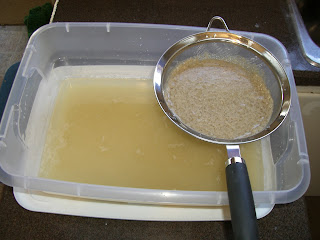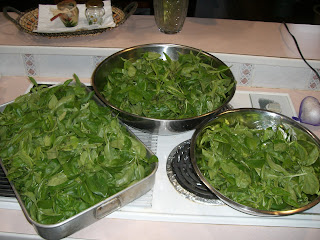This summer we turned the meager backyard we have into the beginnings of a beautiful garden. Jeramy and his dad built a 5 x 20 greenhouse, partially with some "re-claimed" heritage bricks we "aquired". Then we rototilled and sectioned the rest of the yard save a small path. A book to inspire you on creating your own edible greenspace is
Food not Lawns.
Spinach
The best thing of all this year was Spinach!! We froze it and canned it ground it and just ate it. Next year, a little less spinach. In fact, next year will be
Norfolk heirloom spinach from Manitoba's Heritage Harvest Seed
Recipe: Fried Sweet Spinach Stems
When preserving spinach you may take the time to remove the spine. Jeramy did and then he found an amazing way to eat them.
Just fry them on a hot pan with some butter and brown sugar, only for a few minutes so they keep some of their crunch.
Straaaawbrrries
This was the first year for the strawberry patch. There are a few garden center specials and a few heirloom variety that Louis from the Hollyhock Market in Mortlach gave to me. We were worried about how to net this area off from all of the birds. Turns out that we didn't need a net, and we didn't need to feed the cat! That's terrible I know. I remember a saying about viney plants like strawberries and creeper vines
The first year it sleeps, the second it creeps and the third it leaps.
The Greenhouse
The tomato half was okay and the other half was terrible.
Lesson #1 not everything likes to be on a mound, but in a mound...much better.
Lesson #2 Tomato grower extraordinaire, Jeramy's dad buries his tomato plants at least 6" deep. This is important for their elaborate feeder root system. They like being deep. Also, Jeramy wants to plant a fish under one...
Lesson #3 It can be too hot. Tomatoes need to breath too.
Potato Patch Boooooo.....
We planted 2 varieties, Burbank and a fingerling called Banana, allegedly 85-100lbs worth. Beautiful fresh mound, big tall healthy looking foliage and nothing but 5 lbs of stone sized nuggets and some decomposed seed potatoes. SK did have the wettest season since Jesus, but still. Next year no potatoes. They take a lot of room and they are so easy to find at farmer's markets. I got a blue skinned potato for $1.50 / 5lb bag at Moose Jaw's
Yara Community Garden market.
Cayenne Peppers
Along the potato patch we planted cayenne peppers. They took a long time to fruit but when they started you probably could have sat and watched them grow. They had not turned red before we had to pick them but within about 2 weeks they were all red.
Lesson #1 use a knife to save the seeds, not your thumbnail..
Garden Box
This area had squash, mint, parsley and kidney beans.
The Squash vegetated a lot but then got powdery mildew from all of the moisture. Puny little fruits formed then molded. It was gross, we picked it
The Mint hails from the dryer vent in the strawberry patch. If not monitored closely this mint may take over the world. The leaves are the size of my palm..and furry...like it's alive. It'll be there until armageddon, and beyond.
The Parsley, well I like parsley but that much parsley was ridiculous. I was tying it in bunches and giving it in bouquets.Parsley pesto perharps.
 |
| Holy Mint!! |
The Kidney Beans were planted late and all things considered they did okay. They're an heirloom so they replaced themselves for next year.
TIP: Start seeds in a large container rather than a peat puck. When they sprout they're fast! Transplanting is hard on them, so do it only once.
Fucit Row
This little gem was a surprise. It is between the fence and the greenhouse and rarely sees breaks of sunshine. Anything leftover we put into this row, a sink or swim row. Turns out mint loves being here. So, I planted 8 types of mint, logical right?. Since mint is perennial, this row will all come back next year. With the addition of
West Coast Seeds CatMint, 10 out of 10 kitties say it's better. Also, as a side note, if you feel inclined to make cat food, this is a tasty addition.
 1lb grated basic soap (see yesterday)
1lb grated basic soap (see yesterday)

























